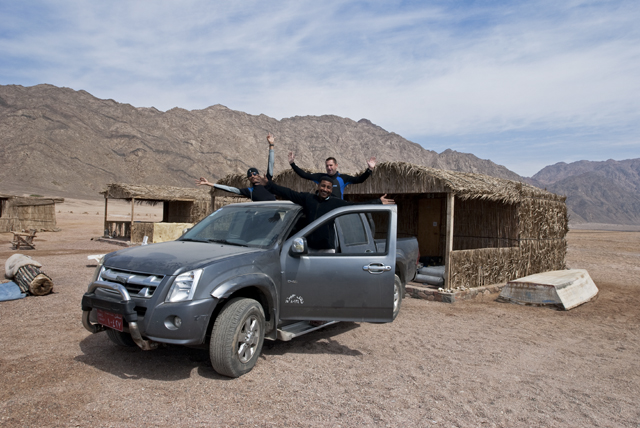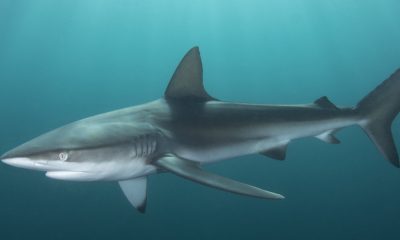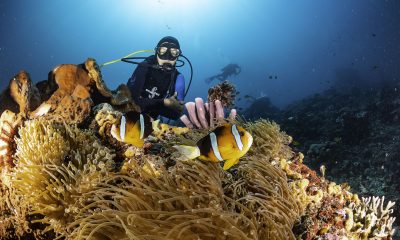News
Carry on Camel

In my mind the combination of scuba diving and riding camels is like putting peanut butter and jelly in the same sandwich; they just don’t go together. I know that camels are called ships of the desert but that’s about the only ‘nautical’ similarity there is between the two! I’m not even sure that camels like getting wet, and when I suggested dunking a camel in the sea my Bedouin guide thought I was stark raving mad and started laughing at me.
My grand Egyptian plan was to get far away from the madding crowds and check out the sites rarely visited by other divers. Using a more traditional mode of transport seemed to fit in with my ‘getting back to basics’ theme, hence bring on the camels. Hayden Falloon, the owner of Black Rock Dive Centre in Dahab, suggested that I sign up for one of his special 2-day camel dive safaris (I think he regretted this later). This would begin with a dive at the world famous blue hole and then follow the coastline trail 10km’s north to the national park at Ras Abu Gulum. Hayden said “this is how Dahab used to be at the beginning. There are no crowded sites, it’s undiscovered diving”.
Although I had visited Egypt many times before I had never quite got around to ‘driving’ a camel. Friends and colleagues had warned me about these smelly fly infested creatures that had a tendency to spit but my nose for adventure overrode all the negative vibes. I had visions of the movie classics ‘Carry on follow that Camel’ and ‘Lawrence of Arabia’. I wondered which role would have best suited me?
Hayden forewarned me not to expect too much. Accommodation and toilet facilities would be very ‘basic’ and the food would be Bedouin style. Hayden also said I would sleep over at a place called the blue lagoon. Hayden had stayed there around 20-30 times in the past 10 years, so if Hayden said it was good enough for him then I’m sure it would be good enough for me. Even a fully domesticated Brit could withstand 2 days worth of roughing it, surely?
The idiot abroad, Dave Brooks, had also signed up for the 2-day trip so at least there would be someone else going through the whole experience with me. Dave fancied himself as a ‘Lawrence’ type character which earned him the apt title ‘Dave of Dahab’.
Hayden had made all the prior arrangements so within a few hours of arriving at Sharm Airport we had packed up our bare essentials, which in my case basically comprised of a toothbrush and 2 pairs of clean underpants, and made tracks for the blue hole. Mamdouh Abdelhalim had been recruited as ‘camel leader’ for our epic adventure. Mamdouh was full of useful information about camels, Bedouins and all things Egyptian which I will slide into the story as and when appropriate.
The blue hole was not what I had expected. I had pictured a few camels and Bedouin tents set up by the water’s edge, not row upon row of white jeeps and 2 storey buildings. There were crowds of people everywhere, snorkelling, freediving, scuba diving, eating, drinking and just generally milling about. We kitted up by the water’s edge and then followed Mamdouh around the corner to the entry point known as bells. I briefly stopped at the ‘wall of death’ to read the memorials of divers who had lost their lives inside the hole. I didn’t realise there had been so many fatalities. Official numbers are quoted around the 40 mark but many think that the true tally is into 3 figures. A dive site called the arch seems to be the main culprit. The apex of the arch, which is basically a 25 metre long swim through, begins at about 54 – 56 metres and drops away to 100 plus metres. This is way beyond recreational limits and into the realms of tech diving (I managed to experience the dive for myself a few days after the camel safari with h2o divers, a professional technical diving outfit. There will be a full article on tech diving in the blue hole on Scubaverse.com soon).
We queued up at the entry point, bells, which turned out to be a small crevice in the reef. Mamdouh suggested that we jump in and then put our fins on while bobbing about on the surface. I went head-first down the hole and came out at around 27 metres. Divers usually ‘clang’ their tanks on the sides of the hole which is how it got the name bells. While I was setting up a shot of Mamdouh coming out at the bottom a huge napoleon wrasse rocked up behind me. Mamdouh’s incessant screaming was enough to put me off my picture taking. We drifted along the wall peering under the ledges and overhangs. We reached ‘the saddle’ about 200 metres later and then crossed over into the blue hole itself. Unfortunately the milky conditions were far from ideal. At best the visibility topped 4 or 5 metres due to a freak algae bloom. I could just about make out the usual array of reef fish and hard corals and the shadowy outline of a giant grouper swimming below us.
 Our camels didn’t turn up until later in the afternoon. Dave had already tooled himself up with a Keffiyeh (head dress) and was eager to get going. Full dive gear including cylinders and weight belts were carefully loaded onto our rides. Mamdouh said that camels can carry loads of up to 300kg. Mounting a camel required some intense concentration. From a sitting down position the camel first came up on its hind legs and then its front legs. Grabbing the saddle horns for balance is a critical part of the ‘staying on’ process. There must have been a good 2 metres clearance from the ground. Mamdouh said wearing jeans and shoes would make the journey more comfortable. Plenty of sunscreen was also a must. Instead of using the stirrups I crossed my legs Bedouin style and held onto the rope attached to the camels head. The rolling motion took a while to get used to. How could these clumsy looking animals be so sure footed? The shoreline was precariously rocky. If I tumbled off there would be some serious damage. Mamdouh even pointed out a pile of camel bones at the base of the cliff we were climbing just to make me feel more at ease. Camels live for around 30 years and cost about 6,000 Egyptian pounds (£600 Sterling) to buy. They can last as long as 2 weeks without water and even taste good to eat. I could now see why camels were such a useful animal. Dave seemed to be having a few problems with steering his camel and ended up going off the track while mine decided to stop for a quick chew on a discarded bamboo stick. We had absolutely no control at all. After 2 hours of plodding along we caught site of our final destination, Ras Abu Gulum. When I dismounted the word ‘rawhide’ took on a whole new meaning. So this is how cowboys must have felt after a hard day in the saddle?
Our camels didn’t turn up until later in the afternoon. Dave had already tooled himself up with a Keffiyeh (head dress) and was eager to get going. Full dive gear including cylinders and weight belts were carefully loaded onto our rides. Mamdouh said that camels can carry loads of up to 300kg. Mounting a camel required some intense concentration. From a sitting down position the camel first came up on its hind legs and then its front legs. Grabbing the saddle horns for balance is a critical part of the ‘staying on’ process. There must have been a good 2 metres clearance from the ground. Mamdouh said wearing jeans and shoes would make the journey more comfortable. Plenty of sunscreen was also a must. Instead of using the stirrups I crossed my legs Bedouin style and held onto the rope attached to the camels head. The rolling motion took a while to get used to. How could these clumsy looking animals be so sure footed? The shoreline was precariously rocky. If I tumbled off there would be some serious damage. Mamdouh even pointed out a pile of camel bones at the base of the cliff we were climbing just to make me feel more at ease. Camels live for around 30 years and cost about 6,000 Egyptian pounds (£600 Sterling) to buy. They can last as long as 2 weeks without water and even taste good to eat. I could now see why camels were such a useful animal. Dave seemed to be having a few problems with steering his camel and ended up going off the track while mine decided to stop for a quick chew on a discarded bamboo stick. We had absolutely no control at all. After 2 hours of plodding along we caught site of our final destination, Ras Abu Gulum. When I dismounted the word ‘rawhide’ took on a whole new meaning. So this is how cowboys must have felt after a hard day in the saddle?
 Clear blue sky, rugged mountains and km upon km of deserted coastline; this definitely scored a 10 out of 10 on the scenic ‘wow factor’ and what a total contrast to the blue hole. Mamdouh said that our first dive site would be Daheila. We kitted up and waded straight into the water. I followed Dave and Mamdouh down to 25 metres. The corals were in pristine condition with plenty of fish activity from damsels to predatory jacks. But we were still suffering with poor visibility which, on a photography level, was seriously stressing me out. Macro shots were okay but wide angle was causing me big problems.
Clear blue sky, rugged mountains and km upon km of deserted coastline; this definitely scored a 10 out of 10 on the scenic ‘wow factor’ and what a total contrast to the blue hole. Mamdouh said that our first dive site would be Daheila. We kitted up and waded straight into the water. I followed Dave and Mamdouh down to 25 metres. The corals were in pristine condition with plenty of fish activity from damsels to predatory jacks. But we were still suffering with poor visibility which, on a photography level, was seriously stressing me out. Macro shots were okay but wide angle was causing me big problems.
Our second dive site was located approx 1km north at a place called Al Garden or the rock. Walking over the slippery stones in full kit was a bit tricky, especially when the oncoming waves were knocking us off balance. We ducked down and followed the contours of the sandy slope to a depth of 20 metres. There were giant table corals and clumps of reef bursting with bright orange anthias, anemone fish, groupers and lionfish. Mamdouh’s favourite spot was a coral pinnacle full of juvenile trigger fish. In clear, calm conditions this would have been an awesome shore dive.
 Hayden described our accommodation as ‘rustic’. I guess that was a good word to use. I’m not sure what star rating I would give the place. It was basically a lean-too on the beach. But to be honest this just added to the atmosphere. The natural shallow lagoon was perfect for kite and wind surfing. Hayden said ‘there are no buildings around to cause any wind pollution’. I saw one lone kite surfer having a whale of a time. I wondered how long it would be before mass tourism found the blue lagoon? I sat chilling with Dave drinking a few beers and eating our spicy fish supper. The night sky was alive with so many shooting stars. The only artificial glow of lights was way off in the distance in the direction of Dahab.During the night I dreamt up an interesting idea for a picture. Why not get a camel to sit in the sea with a scuba diver posing in the saddle (well, it seemed like a good idea at the time). Using my wide angle dome port I could even try for a 50/50 above/below water shot. Dave from Dahab was willing to give it a try so we just needed to find a sacrificial camel. After greasing a Bedouin’s palm with a wad of Egyptian pounds we managed to persuade a camel to go into the water. But as I lined up for a picture the camel decided to offload a pile of poo which floated down in my direction. Obviously the shock of the cold water was enough to start off a chain reaction! In the camels defence it was only mid-April and the water temp was still a cool 21 – 22 degrees. I had all of 2 minutes to get my picture before the camel decided enough was enough and got up with Dave still holding on for dear life. We tried to get the camel back in the water but it just wasn’t having it.
Hayden described our accommodation as ‘rustic’. I guess that was a good word to use. I’m not sure what star rating I would give the place. It was basically a lean-too on the beach. But to be honest this just added to the atmosphere. The natural shallow lagoon was perfect for kite and wind surfing. Hayden said ‘there are no buildings around to cause any wind pollution’. I saw one lone kite surfer having a whale of a time. I wondered how long it would be before mass tourism found the blue lagoon? I sat chilling with Dave drinking a few beers and eating our spicy fish supper. The night sky was alive with so many shooting stars. The only artificial glow of lights was way off in the distance in the direction of Dahab.During the night I dreamt up an interesting idea for a picture. Why not get a camel to sit in the sea with a scuba diver posing in the saddle (well, it seemed like a good idea at the time). Using my wide angle dome port I could even try for a 50/50 above/below water shot. Dave from Dahab was willing to give it a try so we just needed to find a sacrificial camel. After greasing a Bedouin’s palm with a wad of Egyptian pounds we managed to persuade a camel to go into the water. But as I lined up for a picture the camel decided to offload a pile of poo which floated down in my direction. Obviously the shock of the cold water was enough to start off a chain reaction! In the camels defence it was only mid-April and the water temp was still a cool 21 – 22 degrees. I had all of 2 minutes to get my picture before the camel decided enough was enough and got up with Dave still holding on for dear life. We tried to get the camel back in the water but it just wasn’t having it.
Our initial plans were for 3 dives a day plus a night dive, but we decided to cut our trip short due to the adverse conditions. Instead of returning to the blue hole on camels we got a lift back in Hayden’s pick-up truck. To be honest I thought the camel ride was far more comfortable. Hayden’s pick-up really did take a heavy beating over the rough terrain. I definitely wouldn’t want to pay his next maintenance bill. I asked Dave what he thought about the safari and he said ‘It was an adventure. It was nothing like staying in a 5 star hotel, but that’s why you try out different things, to make life more interesting’. This was Dave’s first experience on a camel. He said “I was apprehensive at first. They seemed to have a mind of their own”. I asked Dave if he would go again and he said “Next time I would go later in the year when it’s a bit warmer”.
 I was still determined to get my camel picture, so a few days later I returned with Hayden and Nic from Black Rock diving to try again. This time we walked all the way from the blue hole to Ras Abu Gulum. Hayden’s breakneck pace was similar to a forced march in the French Foreign Legion. In the sweltering hot midday sun it was more a case of march or die! Hayden had recruited Bedouin rider Telal and his trusty steed Asfall, the coolest of all camels, for the photo shoot. This time I managed to get 4 x 5 minute sessions with Nic astride Asfall and was much happier with the pictures. Now I could understand why no one else had attempted this composition before.
I was still determined to get my camel picture, so a few days later I returned with Hayden and Nic from Black Rock diving to try again. This time we walked all the way from the blue hole to Ras Abu Gulum. Hayden’s breakneck pace was similar to a forced march in the French Foreign Legion. In the sweltering hot midday sun it was more a case of march or die! Hayden had recruited Bedouin rider Telal and his trusty steed Asfall, the coolest of all camels, for the photo shoot. This time I managed to get 4 x 5 minute sessions with Nic astride Asfall and was much happier with the pictures. Now I could understand why no one else had attempted this composition before.
Hayden said he organised camel dive safaris that went still further up the coast to Lagoona and beyond. Normally they lasted 2 days and 2 nights but this can be tailored to suit. I would recommend going slightly later in the season as April can still be quite chilly at night, especially when the wind blows. While Dave and I were shivering away our guide Mamdouh was tucked up snug and toasty inside his sleeping bag- thanks for your concern Mamdouh!
Prices for Black Rock’s camel dive safari are approx 80 euro a day on top of the normal dive price. This includes all transfers, soft drinks, food, accommodation, camels and diving.
Blogs
Northern Red Sea Reefs and Wrecks Trip Report, Part 3: The Mighty Thistlegorm

Jake Davies boards Ghazala Explorer for an unforgettable Red Sea diving experience…
Overnight, the wind picked up, making the planned morning dive a bit bumpy on the Zodiacs to the drop point on Thomas Reef. There, we would dive along the reef before descending through the canyon and then passing under the arch before ascending the wall with a gentle drift. The site provided great encounters with more pelagic species, including shoals of large barracuda, tuna, and bigeye trevally.
Once back on the boat, it was time to get everything tied down again as we would head back south. This time, with the wind behind us, heading to Ras Mohammed to dive Jackfish Alley for another great gentle drift wall dive before then heading up the coast towards the Gulf of Suez to moor up at the wreck of the Thistlegorm. This being the highlight wreck dive of the trip and for many onboard, including myself, it was the first time diving this iconic wreck. I had heard so much about the wreck from friends, and globally, this is a must on any diver’s list. Fortunately for us, there was only one other boat at the site, which was a rarity. A great briefing was delivered by Ahmed, who provided a detailed background about the wreck’s history along with all the required safety information as the currents and visibility at the site can be variable.
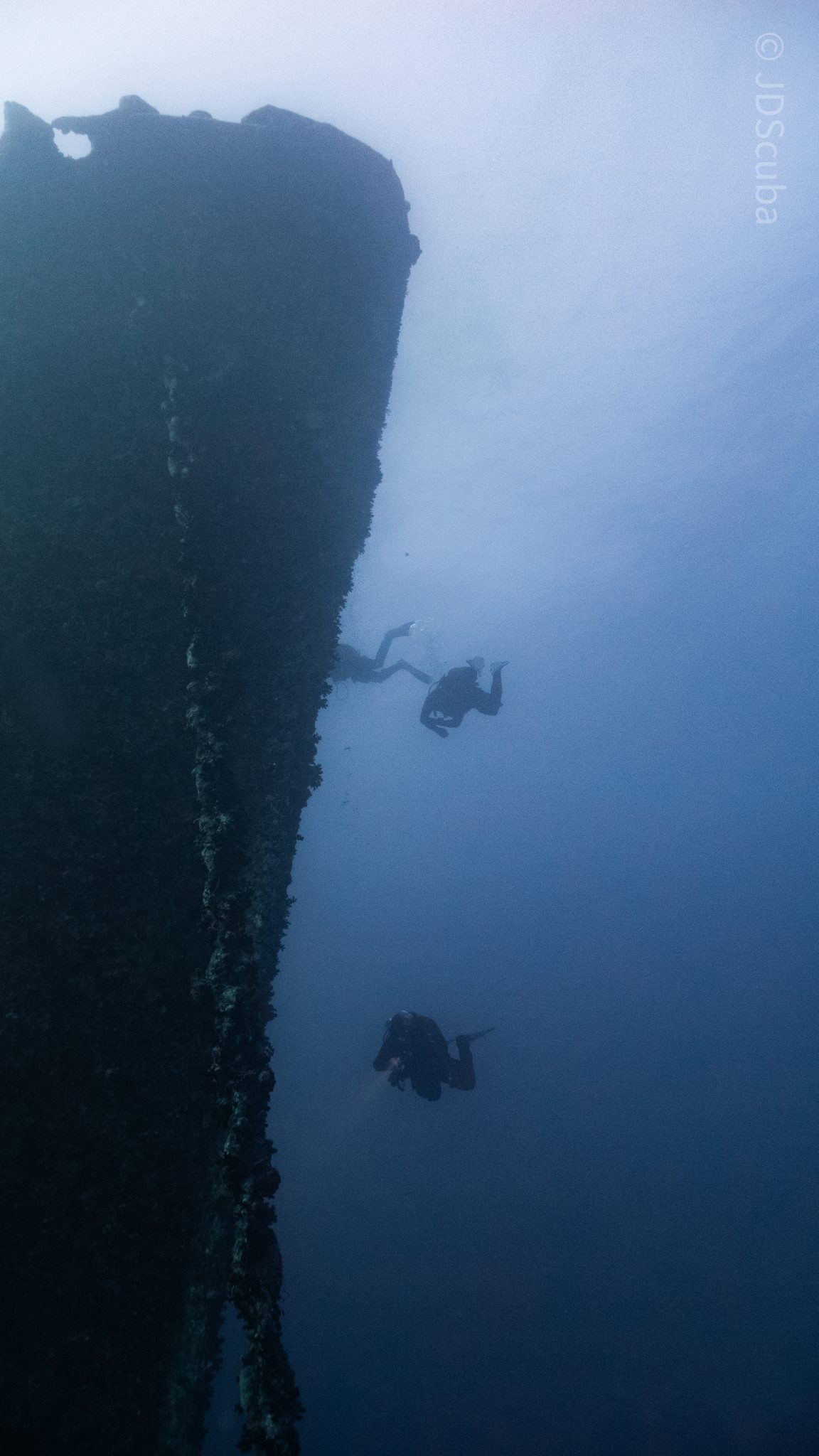
Kitting up, there was a lot of excitement on deck before entering the water and heading down the shoreline. Descending to the wreck, there was a light northerly current which reduced the visibility, making it feel more like the conditions that can be found off the Welsh coast. At 10m from the bottom, the outline of the wreck appeared as we reached the area of the wreck which had been bombed, as our mooring line was attached to part of the propeller shaft. Arriving on deck, instantly everywhere you looked there were many of the supplies which the ship was carrying, including Bren Carrier tanks and projectiles that instantly stood out.
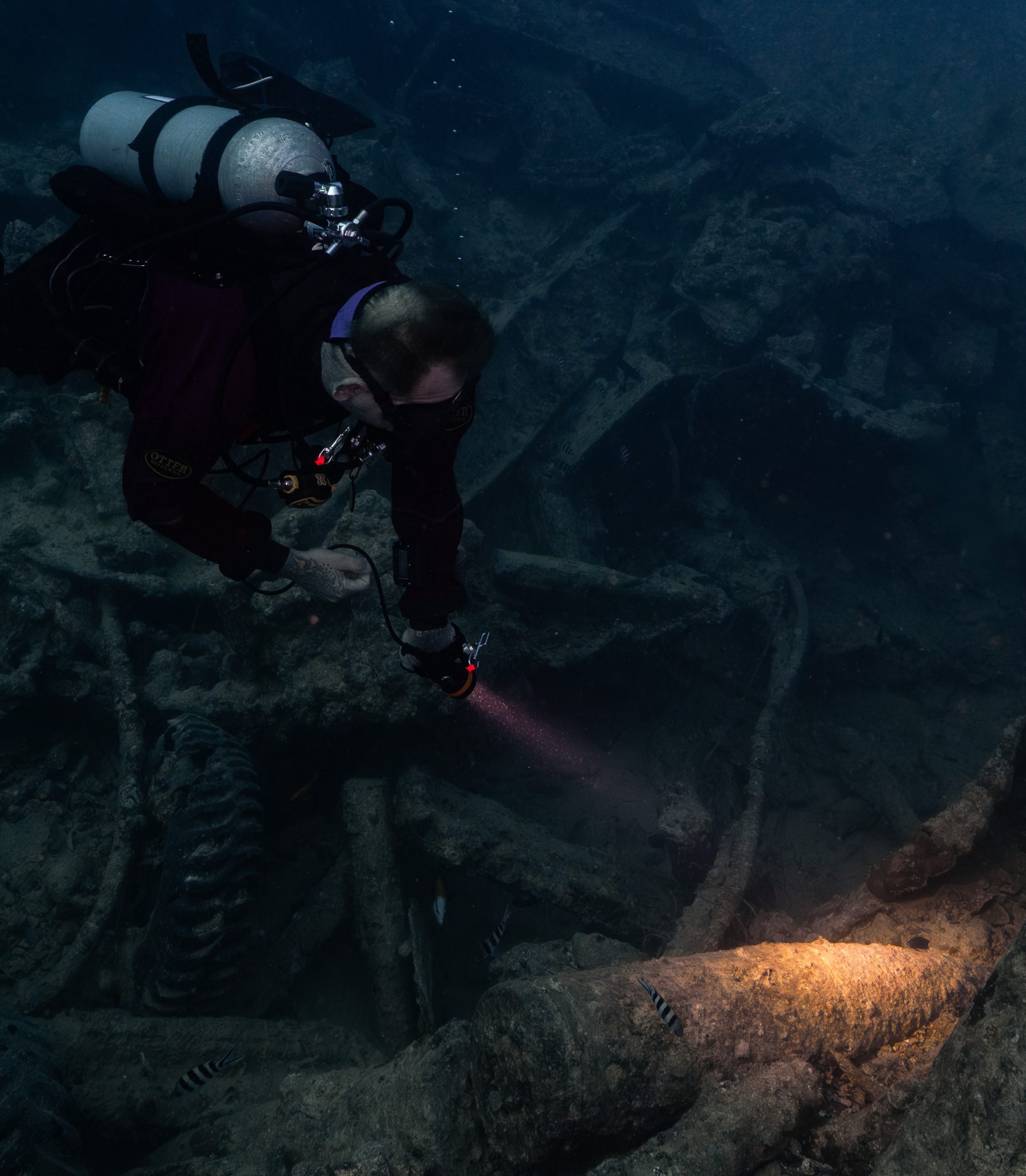
We headed around the exterior, taking a look at the large propeller and guns mounted on deck before entering the wreck on the port side to take a look in the holds. It was incredible to see all the trucks, Norton 16H, and BSA motorcycles still perfectly stacked within, providing a real snapshot in time.
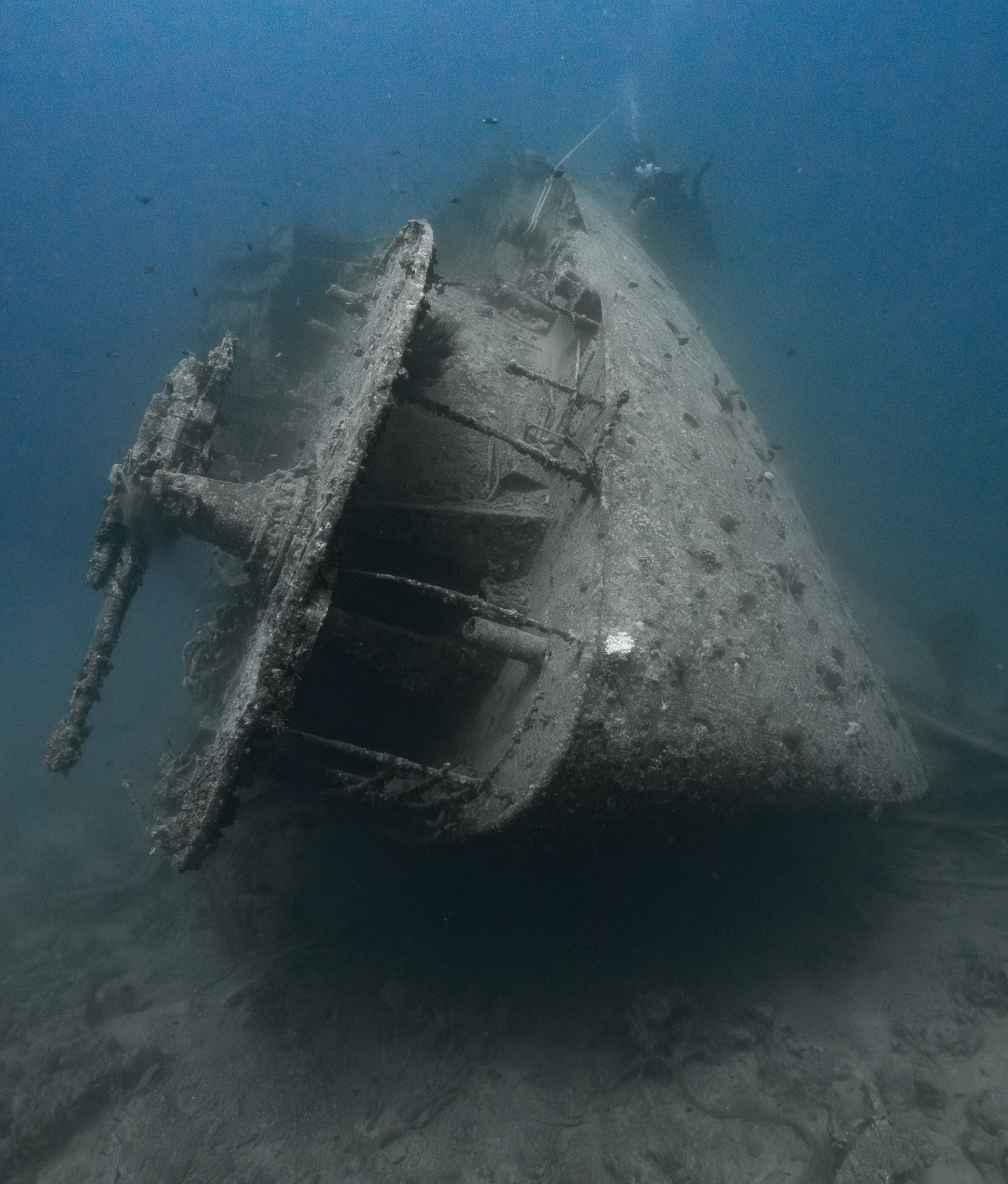
Overall, we had four dives on the Thistlegorm, where for all of the dives we were the only group in the water, and at times, there were just three of us on the whole wreck, which made it even more special, especially knowing that most days the wreck has hundreds of divers. Along with the history of the wreck, there was plenty of marine life on the wreck and around, from big green turtles to batfish, along with shoals of mackerel being hunted by trevally. Some unforgettable dives.

The final leg of the trip saw us cross back over the Suez Canal to the Gobal Islands where we planned to stay the night and do three dives at the Dolphin House for the potential of sharing the dive with dolphins. The site, which included a channel that was teeming with reef fish, especially large numbers of goatfish that swam in large shoals along the edge of the reef. These were nice relaxing dives to end the week. Unfortunately, the dolphins didn’t show up, which was okay as like all marine life they are difficult to predict and you can’t guarantee what’s going to be seen. With the last dive complete, we headed back to port for the final night where it was time to clean all the kit and pack before the departure flight the next day.

The whole week from start to finish on Ghazala Explorer was amazing; the boat had all the facilities you need for a comfortable week aboard. The crew were always there to help throughout the day and the chefs providing top quality food which was required after every dive. The itinerary providing some of the best diving with a nice mixture of wreck and reef dives. I would recommend the trip to anyone, whether it’s your first Red Sea liveaboard in the Red Sea or you’re revisiting. Hopefully, it’s not too long before I head back to explore more of the Red Sea onboard Ghazala Explorer.
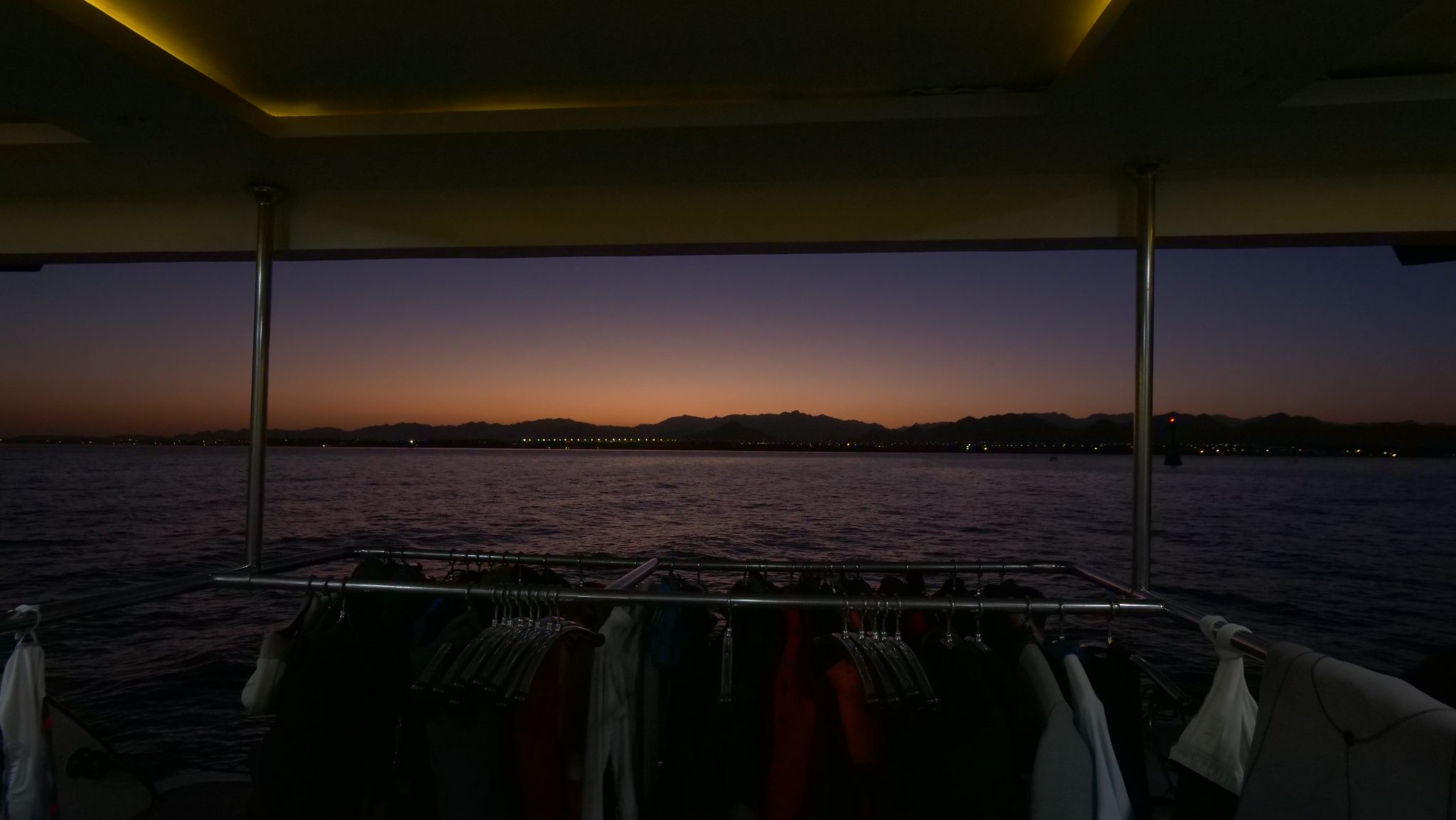
To find out more about the Northern Red Sea reef and wrecks itineraries aboard Ghazala Explorer, or to book, contact Scuba Travel now:
Email: dive@scubatravel.com
Tel: +44 (0)1483 411590
Photos: Jake Davies / Avalon.Red
Blogs
Northern Red Sea Reefs and Wrecks Trip Report, Part 2: Wall to Wall Wrecks
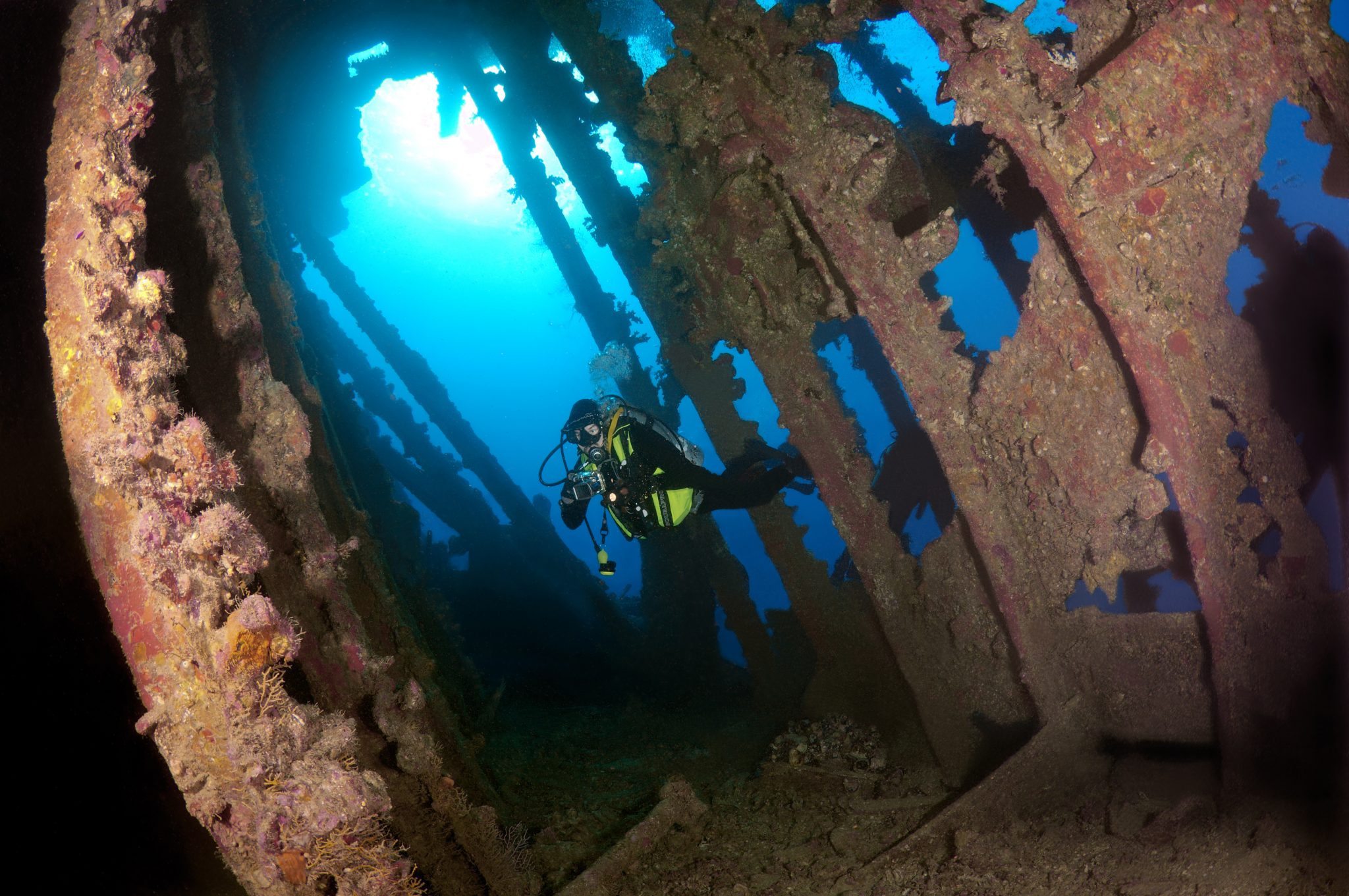
Jake Davies boards Ghazala Explorer for an unforgettable Red Sea diving experience…
The second day’s diving was a day full of wreck diving at Abu Nuhas, which included the Chrisoula K, Carnatic, and Ghiannis D. The first dive of the day was onto the Chrisoula K, also known as the wreck of tiles. The 98m vessel remains largely intact where she was loaded with tiles which can be seen throughout the hold. The stern sits at 26m and the bow just below the surface. One of the highlights of the wreck is heading inside and seeing the workroom where the machinery used for cutting the tiles are perfectly intact. The bow provided some relaxing scenery as the bright sunlight highlighted the colours of the soft coral reef and the many reef fish.
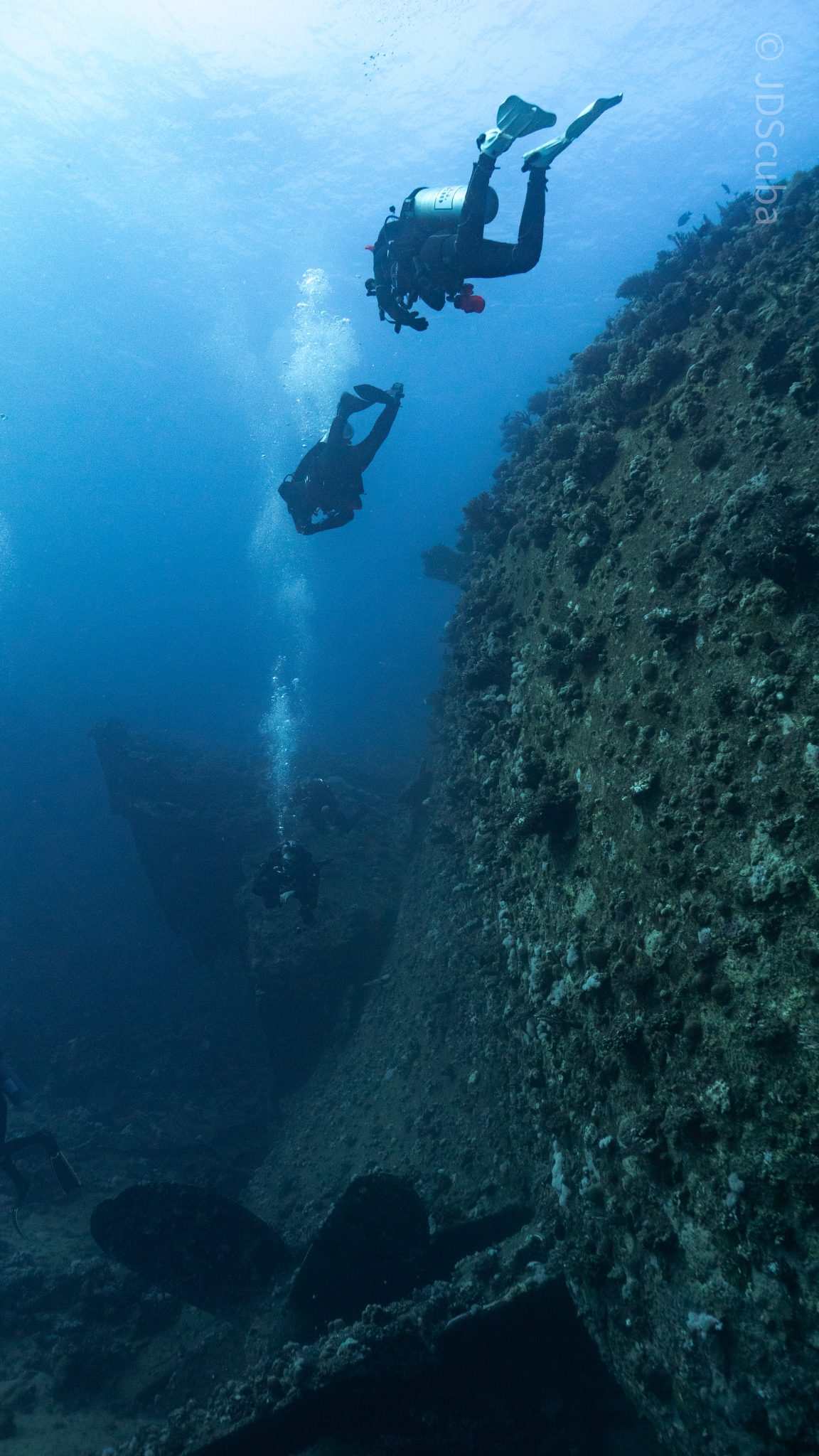
Following breakfast, we then headed to the next wreck, which was the Carnatic. The Carnatic is an 89.9m sail steamer vessel that was built in Britain back in 1862. She ran aground on the reef back in 1869 and remains at 27m. At the time, she was carrying a range of items, including 40,000 sterling in gold. An impressive wreck where much of the superstructure remains, and the two large masts lay on the seafloor. The wooden ribs of the hull provide structures for lots of soft corals, and into the stern section, the light beams through, bouncing off the large shoals of glass fish that can be found using the structure as shelter from the larger predators that are found outside of the wreck.
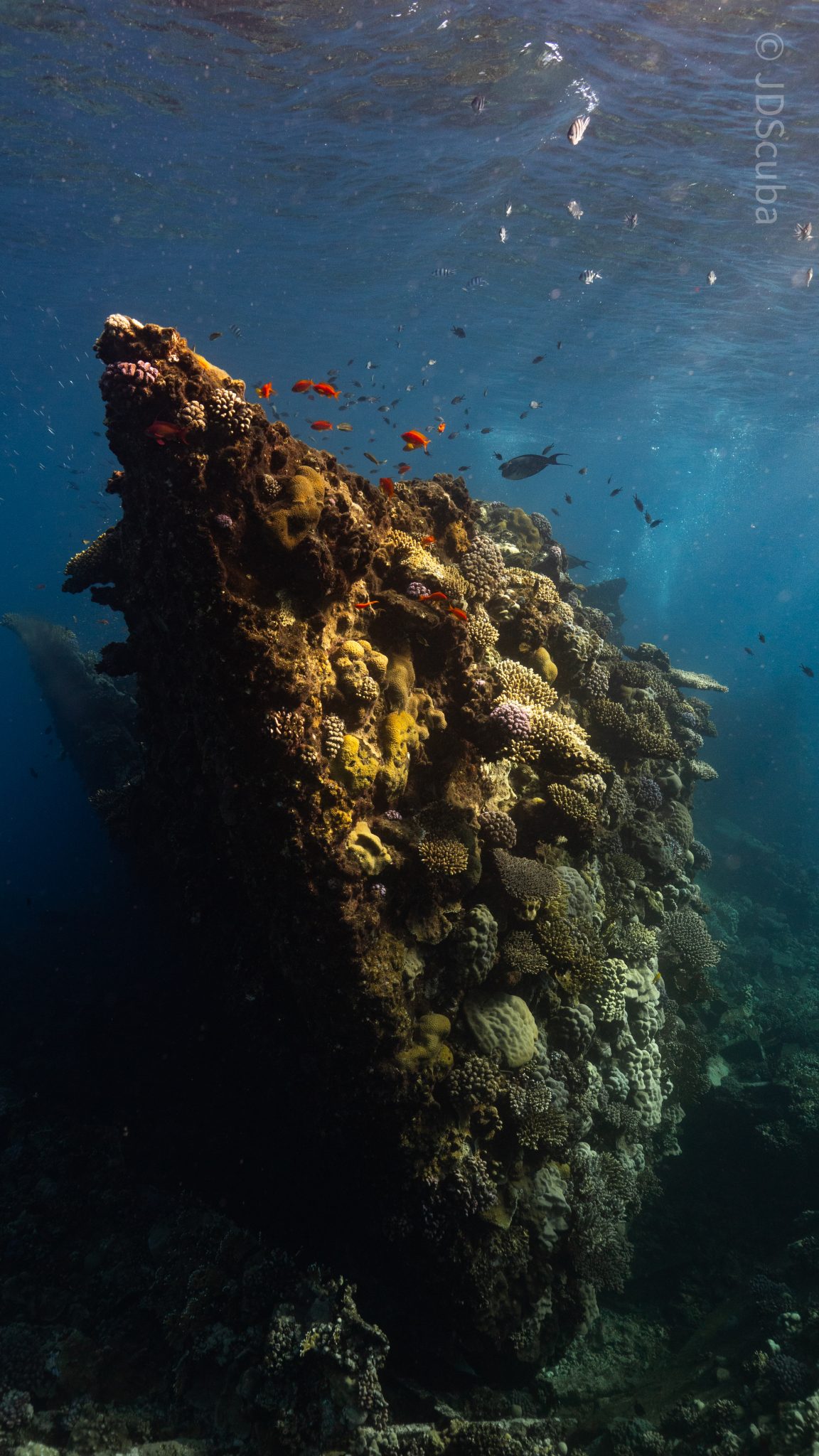
The final wreck at Abu Nuhas was the Ghiannis D, originally called ‘Shoyo Maru,’ which was 99.5m long and built in Japan back in 1969 before becoming a Greek-registered cargo ship in 1980. The ship then ran aground on the reef on April 19th, 1983, and now sits at the bottom at a depth of 27m. Heading down the line, the stern of the ship remains in good condition compared to the rest of the hull. The highlight of the wreck, though, is heading into the stern section and down the flights of stairs to enter the engine room, which remains in good condition and is definitely worth exploring. After exploring the interior section of the ship, we then headed over to see the rest of the superstructure, where it’s particularly interesting to see the large table corals that have grown at the bow relatively quickly considering the date the ship sank. After surfacing and enjoying some afternoon snacks, we made sure everything was strapped down and secured as we would be heading north and crossing the Gulf of Suez, where the winds were still creating plenty of chop.

The next morning, it was a short hop to Ras Mohammed Nature Reserve for the next couple of days of diving. The 6am wake-up call came along with the briefing for the first site we would be diving, which was Shark & Yolanda. The low current conditions allowed us to start the dive at Anemone City, where we would drift along the steep, coral-filled wall. These dives involved drifts, as mooring in Ras Mohammed wasn’t allowed to protect the reefs. As a dive site, Shark & Yolanda is well-known and historically had a lot of sharks, but unfortunately not so many in recent years, especially not so early in the season. However, there was always a chance when looking out into the blue.
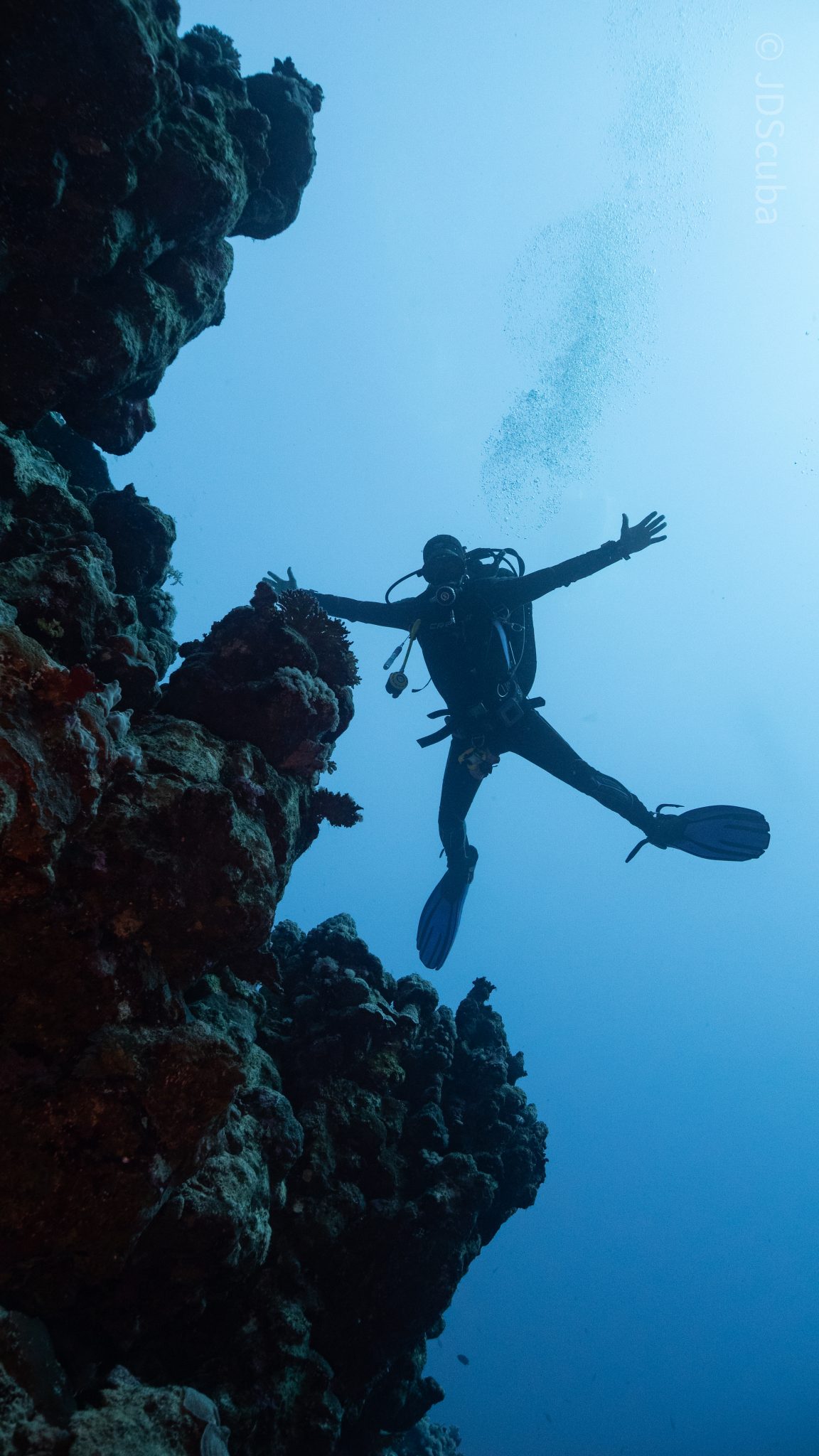
The gentle drift took us along the steep walls of the site, with plenty of anemone fish to be seen and a huge variety of corals. It wasn’t long into the dive before we were accompanied by a hawksbill turtle, who drifted with us between the two atolls before parting ways. Between the two reefs, the shallow patch with parts of coral heads surrounded by sand provided the chance to see a few blue-spotted stingrays that were mainly resting underneath the corals and are always a pleasure to see. With this being the morning dive, the early sunlight lit up the walls, providing tranquil moments. Looking out into the blue, there was very little to be seen, but a small shoal of batfish shimmering underneath the sunlight was a moment to capture as we watched them swim by as they watched us.

Towards the end of the dive, we stopped at the wreck of the Jolanda where the seafloor was scattered with toilets from the containers it was carrying. This provided a unique site to make a safety stop, which was also accompanied by a large barracuda slowly swimming by, along with a hawksbill turtle calmly swimming over the reef as the sun rays danced in the distance.
For the next dive, we headed north to the Strait of Tiran to explore the reefs situated between Tiran Island and Sharm El Sheik, which were named after the British divers who had found them. We started on Jackson before heading to Gordons Reef, where we also did the night dive. All the atolls at these sites provided stunning, bustling coral reefs close to the surface and steep walls to swim along, which always provided the opportunity to keep an eye out for some of the larger species that can be seen in the blue. Midwater around Jackson Reef was filled with red-toothed triggerfish and shoals of banner fish, which at times were so dense that you couldn’t see into the blue. Moments went by peacefully as we enjoyed the slow drift above the reef, watching these shoals swim around under the mid-afternoon sun.
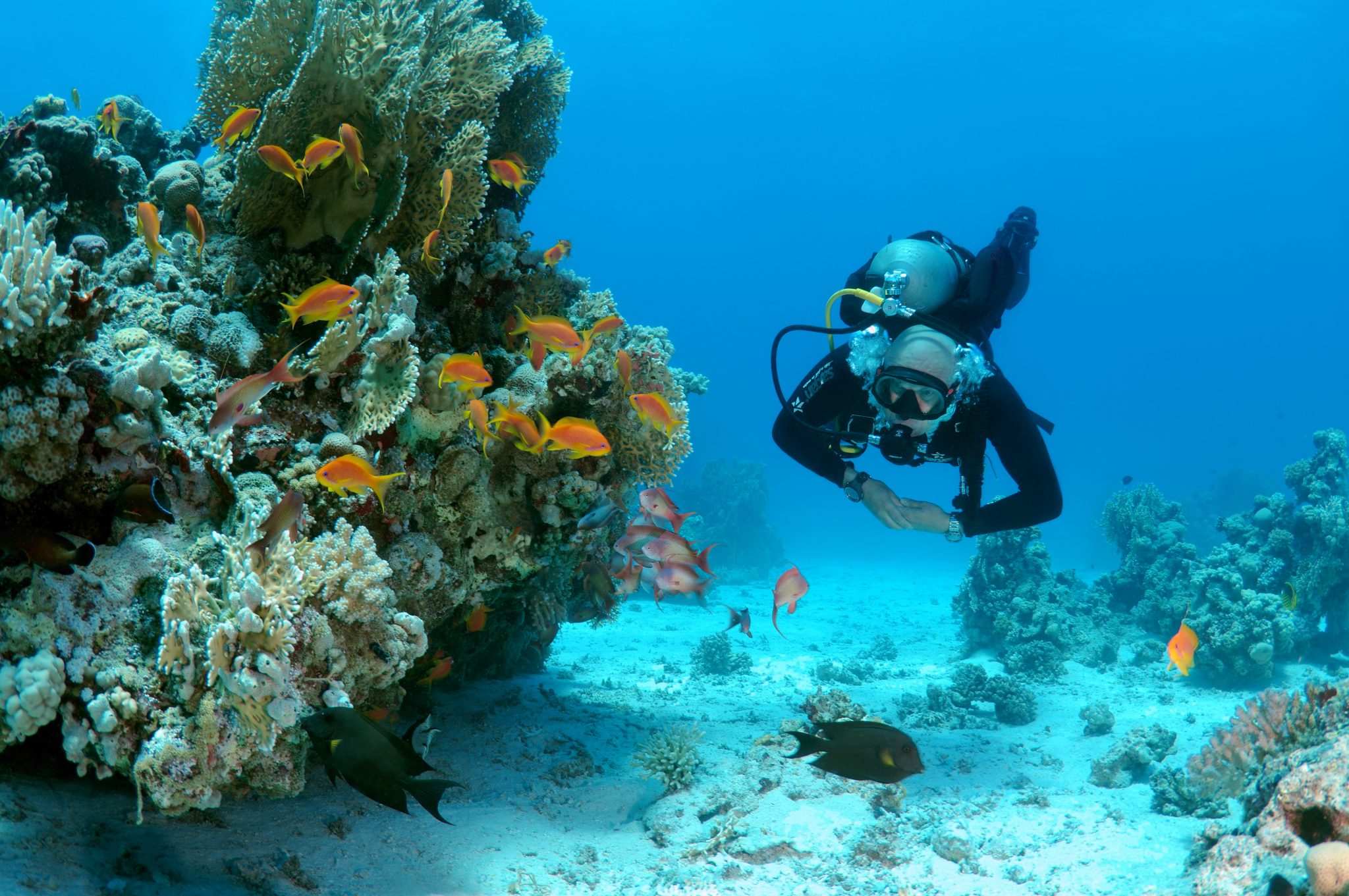
The night dive at Gordon’s Reef was mainly among the stacks of corals surrounded by sand, which was great to explore under the darkness. After some time circling the corals, we came across what we were really hoping to find, and that was an octopus hunting on the reef. We spent the majority of the dive just watching it crawl among the reef, blending into its changing surroundings through changes in colour and skin texture. It’s always so fascinating and captivating to watch these incredibly intelligent animals, in awe of their ability to carry out these physical changes to perfectly blend into the reef. Before we knew it, it was time to head back to the boat to enjoy a well-deserved tasty dinner prepared by the talented chefs onboard.
Check in for the 3rd and final part of this series from Jake tomorrow!
To find out more about the Northern Red Sea reef and wrecks itineraries aboard Ghazala Explorer, or to book, contact Scuba Travel now:
Email: dive@scubatravel.com
Tel: +44 (0)1483 411590
Photos: Jake Davies / Avalon.Red
-

 News3 months ago
News3 months agoHone your underwater photography skills with Alphamarine Photography at Red Sea Diving Safari in March
-

 News3 months ago
News3 months agoCapturing Critters in Lembeh Underwater Photography Workshop 2024: Event Roundup
-

 Marine Life & Conservation Blogs2 months ago
Marine Life & Conservation Blogs2 months agoCreature Feature: Swell Sharks
-

 Blogs2 months ago
Blogs2 months agoMurex Resorts: Passport to Paradise!
-

 Blogs2 months ago
Blogs2 months agoDiver Discovering Whale Skeletons Beneath Ice Judged World’s Best Underwater Photograph
-

 Gear Reviews3 months ago
Gear Reviews3 months agoGear Review: Oceanic+ Dive Housing for iPhone
-

 Marine Life & Conservation2 months ago
Marine Life & Conservation2 months agoSave the Manatee Club launches brand new webcams at Silver Springs State Park, Florida
-

 News3 months ago
News3 months agoWorld’s Best Underwater Photographers Unveil Breathtaking Images at World Shootout 2023





